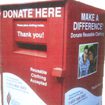
By Michael F. Carmichael
Dec. 15, 2011
It’s a two-part answer.
Part One: If the charity has resale shops the good stuff goes there. The less-marketable things end up - in Part Two
Part Two: If they don’t have retail outlets then the clothes, shoes and, in some cases, household items, as well as the leftovers from Part One go somewhere such as Central States Used Clothing, on the east side of Detroit.

|
There, Jon Harvey sells the clothes and other things by the pound to buyers from Mexico, Central America and Africa. “I work on behalf of five national charities,” Harvey says. “Easter Seals, Cystic Fibrosis, the Cancer Foundation - I buy used clothing from them. When their thrift stores run short, I sell them additional clothing.”
As with most industries, the used clothing business has its own jargon. “Credential” is clothing that has come “direct from Mr. and Mrs. Donor’s home, untouched, unsorted, ungraded,” Harvey explains. “Then there are hard goods, and there are several different categories of them. Things such as pots and pans, sporting goods, hardware - miscel [shorthand for miscellaneous] - like you’d see at a garage sale, 90 percent of that goes to South America or Mexico.”
Harvey’s company exports most of its used clothing to Mexico, South America or to Kenya or Ghana.
There, Harvey says, “I have agents, buyers and complete communities that buy the clothing.” He is particularly proud of his African work. “I can dress a child from head to foot - from hat to shoes - in the best clothing you ever saw for less than a U.S. dollar.”
“There’s a human parasite in Kenya that lives in the ground and it goes through the bottom of the children’s bare feet and goes up their blood system to their brain and kills them. We have a special project to purchase children’s used shoes to ship to Kenya. I even have a slogan for the project - let me find your old shoes a new pair of feet.”
There are only about a dozen similar businesses throughout the United States “and we all know each other,” explains Harvey. “It’s like the stock market. The prices vary literally day-to-day, depending on availability, the weather, politics. Sometimes we’re inundated in used clothing and miscellaneous household items and sometimes there’s a shortage that drives the per-pound price up. We check with each other every day to see what’s going on in Denver, L.A., Boston as to what we’re paying per pound for the product.”
Other factors play a part, says Harvey. “Each load is different, we have to cope with the trucking industry, the export industry and the containers you see on those container ships? I do 40 of those a month.”
Harvey is asked if, on a more macro level, his business tends to mirror the economy or is counter-cyclical. “The worse things get, the better our business. People can’t afford new clothing so they go to the thrift stores and shop and that stuff all came from me.”

|
The used clothing business is also seasonal, at least in northern climes. “The worst season for us is January, February and March. People don’t donate in cold weather. Add to that, the volunteers at the charities won’t go out in the cold weather that’s not being donated anyhow. After April 1 the containers start to be jammed as the result of spring housecleaning. In September we’re busy exporting Christmas goods because it takes six weeks to get there on the container ships. Everyone gets the Christmas spirit after Thanksgiving so there are a lot of donations then. And finally, the week between Christmas and New Years is overwhelming to us because everyone is donating the stuff that’s being replaced by what they got for Christmas,” he laughs.
Surprisingly, Harvey says there’s a huge market for used books. They’re the “bottom of the barrel, price-wise. Where we might pay between 25- and 55-cents a pound for used clothing, used books are 5- to 12-cents a pound - and we need them by the trailer-load. I could export a 40-foot container of used books a day to India every day for the rest of my life. They love American used books. They don’t care if they’re school books, medical books - if it’s in English and from America, they want it.”
Interest in used books in this country is running high as well. An Ohio company, Harvey says, will bring in a complete used book sale to a charity, which then gets a portion of the profits.
Harvey has been a proponent of recycling for years and serves as an international consultant on the subject. He explains that “10 percent of what we throw out in the garbage is wearable used clothing, and it goes to the landfill. Who’s paying for that landfill? You and me! I lecture all over the United States on recycling used clothing. When you go into a recycling center they have a bin for aluminum, a bin for green glass, clear glass, cardboard, office paper - there’s a container in there for everything except used clothes. If I can convince the state-owned or state-funded recycling centers to put in a bin for used clothing - and put it out every 90 days for bid - you’re going to extend the life of the landfills.”
Pennsylvania is an example of Harvey’s ideal recycling center. “They’re beautiful! It’s ‘Come in, put your stuff in the bins, have a cup of coffee and a donut’ and they’re making a lot of money off of them. The Allentown center is probably the biggest state-owned recycling facility in the nation and they’re putting in three bins. Two are for clothes and one is for used shoes. When the bins are full they put the contents out to bid from people like me.”

|
An unusual use for some of Harvey’s used clothing is as a component of Detroiter Tyree Guyton’s Heidelberg Project. “He worked on a piece of art and I provided two blocks of used shoes,” Harvey says proudly.
Harvey cautions potential donors not to place their donations in a box operated by a charity they don’t know. “There’s a firm headquartered in Amsterdam and the bins bear the name of a phony charity. The guy’s got 7,000 bins. He’s been chased out of Europe and now he’s in the United States. Here everybody’s after him - immigration, income tax - the whole thing’s a scam. He places those bins anyplace he wants without asking the property owner. He doesn’t check for zoning. If he finds one of our Easter Seals bins - they’re red with a picture of a little girl in a wheelchair being pushed by another one - he puts his next to it. Or, in front of it.”
Whether you’re donating a barely used suit or a well-loved shirt or pair of shoes - even things that you don’t think anyone would wear - go ahead and do it, in a bin or at the resale shop of a charity you know and trust. And think of Jon Harvey when you do.








